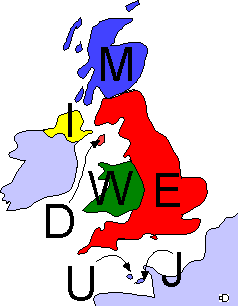



Types of licence and call signs
1A2 Recall the types of UK Amateur Licence
(Foundation, Intermediate, Full) and identify their call signs,
including Regional Secondary Locators and optional suffixes.
Foundation Licence, the entry level
Intermediate Licence, next step
Full Licence, the fullest licence available in UK and for this you need to pass the Advanced Examination.
No grade of licence is prevented from building receivers as it is the transmitters that would cause interference to other pieces of electronic equipment, rather than a receiver.

The Foundation licence only gives you the permission to operate whilst in the United Kingdom.
The United Kingdom includes:-
England, Scotland, Wales, Jersey, Guernsey, Isle of man and Northern Ireland
This is because, whilst there is recognition for what are is called a "Full" UK Amateur Radio Licence for reciprocal operation in other countries, but there is no such blanket recognition of all the UK amateur radio licences. Further it is the choice of the administration of other countries to decide what reciprocal arrangements are made and not for the radio amateur to assume. Thus, as UK is the first country to have a "Foundation Licence" at the moment no mutual reciprocal agreements have yet been made.
Now we may use Regional Secondary Locators (RSL's). These are optional and help to locate a station geographically. These are:
Club stations can use (optional) a club Secondary Locator which is also regional. These are:
Club Secondary locators such our club call G0BRC can be used as GX0BRC.
Format of Foundation, Intermediate and Full call signs
Please read Amateur Radio Licence Guidance Document on OFCOM's web site, but here is a summary:
Let's consider just England for a moment with regard to call sign structure:-
Foundation Licence
M3+3, M6+3, and M7+3 letters are current Foundation Licence call signs in England eg M6AAA
Intermediate Licence
Was 2E0+3 letters call signifies an Intermediate Licence holder grade and in England. Now no longer issued but replaced by M8+3 and M9+3 letters. 2E0 plus 3 letters still are valid call signs.
Full Licence
Current prefixes are M0, M1, M5, G1, G2, G3, G4, G5, G6, G7, G8, G0 with 3 letters. An M0+3 letter call both signify an Full Licence holder grade in England also called a FULL Licence Holder.
Why is England so important ?
The Amateur Licence areas in the United Kingdom is split up into regions :-
England, Scotland, Wales, Northern Ireland, Isle of Man, Jersey, Guernsey.
The call sign around which all other call signs are based at Foundation level is the England call sign of M3,M6, and M7 with 3 following letters such like M3XXX.
To indicate a region other than England there are secondary identifiers used with the "England" call sign this is explained below.
Secondary identifiers also known as Regional identifiers
For the Foundation and Full licence levels Secondary Identifiers, sometimes called REGIONAL IDENTIFIERS are used, (note the absence of the mention of the Intermediate level we mention this just below the pictorial map).
Scotland M, Wales W, Northern Ireland I, Isle of Man D, Jersey J, Guernsey U.

With the Intermediate Call signs the E for England as used 2E0+3 letter call would be substituted for the other secondary identifiers Scotland M, Wales W, Northern Ireland I, Isle of Man D, Jersey J, Guernsey U. eg 2M1+3 letters for Scotland.
For the course exam you will be pleased to hear that you only have to learn how the Secondary Identifiers would be used for a Foundation Licence Holder.
As already stated :-
An M6+3 letter call (eg M6AVI) or M7+3 or M3+3 signifies a Foundation Licence holder in ENGLAND
For the other regions the secondary identifier is added immediately after the initial "M" as shown below.
MM6+3 call would indicate the licence holder has his main station address in SCOTLAND
MW6+3 call would indicate the licence holder has his main station address in WALES
MI6+3 call would indicate the licence holder has his main station address in NORTHERN IRELAND
MD6+3 call would indicate the licence holder has his main station address in Isle of Man
MU6+3 call would indicate the licence holder has his main station address in GUERNSEY
MJ6+3 call would indicate the licence holder has his main station address in JERSEY
We are also allowed to use suffixes. These used to be like /P for portable or /M for mobile operating, but any suffix can be used as long as it does not cause incorrect identification or an offence to anyone.
The origin of some of the text on this page is from the RSGB with additions by the web master